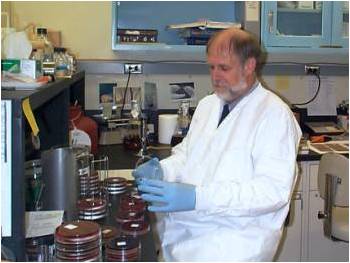A typical set-up for part of our microbiology lab. Pictured instruments include a computer, a microscope for viewing stained slides, a slide warmer to dry samples on slides, incubation timers, and cleaning supplies. Typically there is also a plate-counting bench, although it seems ours isn't pictured here!
Here, Dr. Wahlburn checks some agar plates that have incubated for signs of bacterial growth. Agar plate streaking is a technique used to grow colonies of bacteria, and check for overzealous bacterial growth in a sample of something. A cotton-tipped swab is dipped into a sample, usually sent from somewhere that wants us to test an item or food for bacteria, and then repeatedly swiped over a sterile petri dish filled with agar jelly (a sugar-rich growth material made from algae that bacteria love). The petri dish is then labeled, dated, and placed in an incubator to grow. Once a certain amount of time has passed (generally anywhere from a few days to a few weeks, or even just overnight), the petri dish is removed and the number of colonies is counted. If there are many of them, the sample is contaminated. If there aren't more than 30 colonies, then the sample is not considered heavily contaminated.
Microbiology Technician Lisa Marie sits patiently as I take a shot over her shoulder. Here, she is streaking an agar plate to test for dangerous strains of E. coli. After she is done plating this sample, she will clean the sterile fume hood she is working in with rubbing alcohol, which will kill off any stray bacteria that could contaminate other samples and cause false readings. Her tools will also be cleaned with rubbing alcohol. Sterilization of testing equipment is of utmost importance in epidemiology!
Dr. Allison Jade prepares to place a sample into an instrument specialized for testing water samples for Campylobacter ("Campy"), a bacterium that occurs in contaminated water and causes vomiting and diarrhea. Many times, in areas where flooding or drinking water contamination are suspected, a test for Campy is run to make sure the water is safe. If the test is positive, then the water is not safe to drink and must be monitored until it is cleaned up. Once samples of the water test negative for Campylobacter and other water-borne pathogens, the water is safe to drink again.
Hey, it's me! As the Senior scientist of my lab, I do a lot of research and paperwork. Shown here is the boring part - the office work. At the end of the day, I review all the lab data that was taken and make sure it's all up to snuff. In my office, I can see all the data from today's tests, as well as yesterday's and as far back as 30 years ago. That's a lot of data! There's some very strict guidelines required for testing, so I have to make sure all of the data is properly formatted so I can report to my superiors. The paperwork is the easy part, it's the rigorous testing in the laboratories here that's hard work! All of this work is important in keeping communities safe, hospitals and food prep places sanitary, and keeping tabs on infectious diseases and outbreaks. All part of a day's work!





